The scenic alps of Switzerland are a well-known tourist destination thanks to the country’s associations with the watch, the clock, chocolate, cheese, and political neutrality. The fact that there are three official languages in the country is one of its distinguishing traits. When visiting Switzerland, visitors can hear French, Italian, or German spoken among locals. While there is no official Swiss language, many people in the region near the German border use a variant of German known as Swiss German. If you’re a visitor considering a vacation to Switzerland, you should check out some of these great attractions.
10. Mount Pilatus

A breathtaking view of Pilatus Mountain and Lucerne Lake, Switzerland. Image source: xbrchx/Shutterstock.com
The area around Lake Lucerne, particularly Mount Pilatus, is rife with folklore. It is believed that the prominent Roman ruler of the Bible, Pontius Pilate, was buried atop this mountain, thus the name. The people of medieval Europe thought the mountain was created when a dragon dropped a rock from the sky. Views of the Swiss and French Alps, as well as Lake Lucerne below, can be had from this 2,100-meter-high hill. It has a high-altitude Christmas market in the winter and several hiking trails in the summer. The world’s steepest railway, with slopes of over 48%, provides access to this area.
9. Jet d’Eau
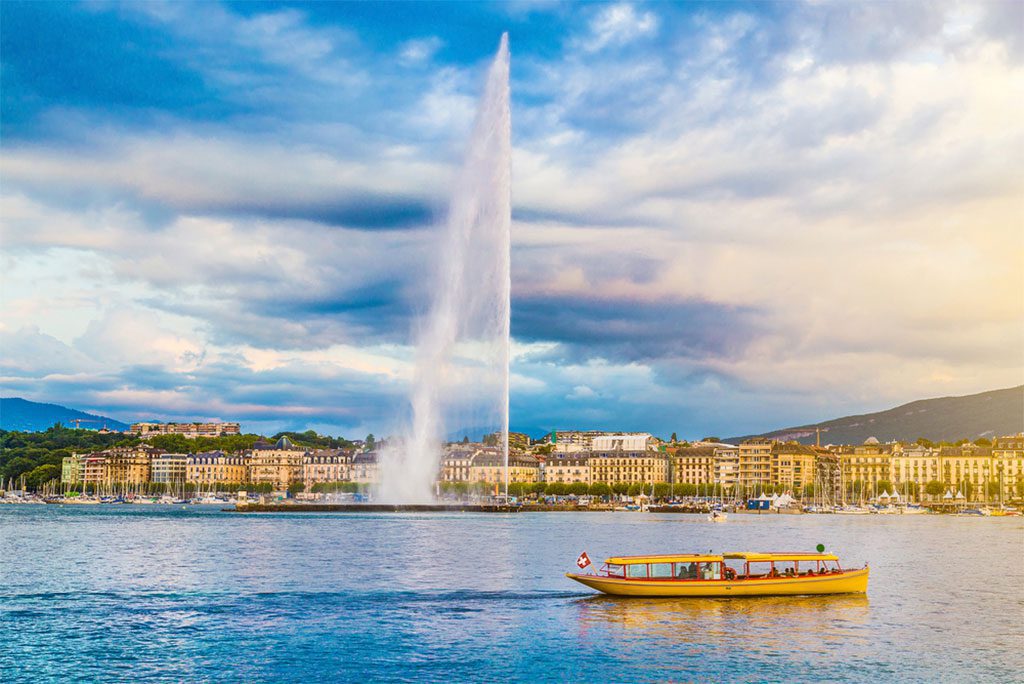
A panoramic view of Geneva skyline with the famous Jet d’Eau fountain in the foreground. Image source: canadastock/Shutterstock.com
One of the most recognizable symbols of Geneva is this massive fountain. The Jet d’Eau, which shoots 140 meters (460 feet) into the air, is located at the point where Lake Geneva meets the Rhone River. Seven tons of water are constantly in the air, and most of it is used to splash onlookers on the pier below. Twice or thrice a year, it is colored differently to celebrate humanitarian events. One of the best places to see the fountain is from the Bains de Paquis, the local bathing area.
8. Grindelwald

An aerial view of Grindelwald village and the Swiss Alps mountains in autumn. Image source: Nataliya Nazarova/Shutterstock.com
In the Jungfrau area, Grindelwald is the most populous ski resort. There are plenty of things to do in the summer and the winter in this picturesque mountain town. In the summer, visitors can experience some of Europe’s best rock climbing spots and breathtaking hiking trails. Tobogganing or skiing are two popular winter activities for visitors. Many mountain ranges can be reached within driving distance, making this an attractive option for hikers, campers, and photographers. Fans of festivals will like the international snow festival’s ice sculptures.
7. Rhine Falls
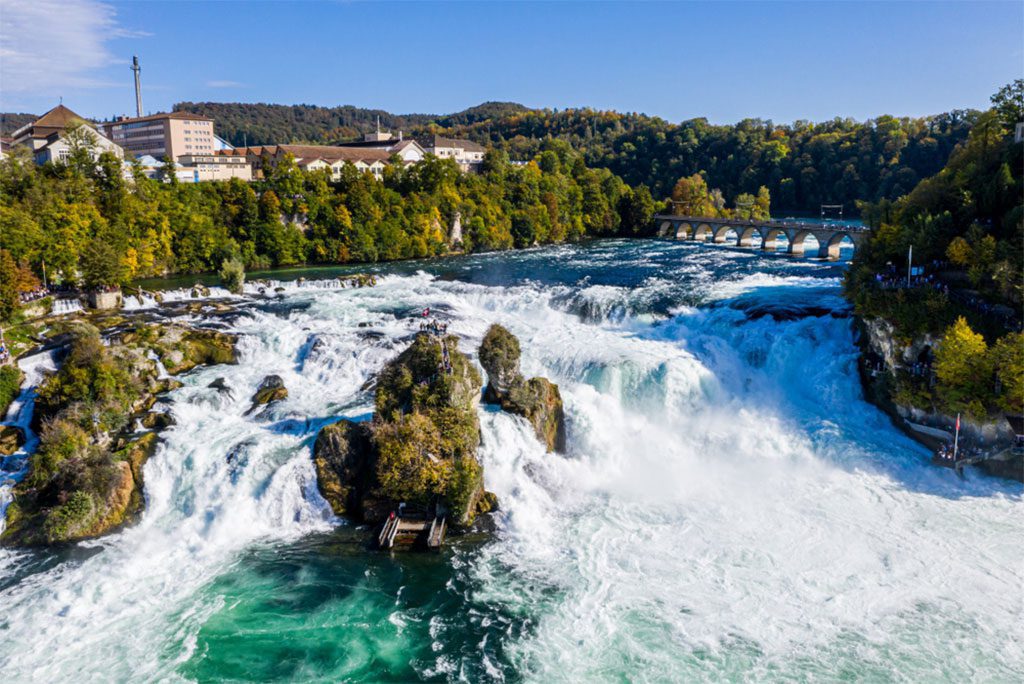
An aerial panoramic view of Rhine Falls in Switzerland. Image source: maloff/Shutterstock.com
Europe’s largest waterfall is located not far from Schaffausen, at the Rhine Falls. A boat trip will take you to the top of the falls, where you can see the incredible rock jutting out into the river and the beautiful basin and riverbank castles. It is possible to get a bird’s-eye view of the falls from elevated platforms that extend out over the edge. The visitor’s center is a great way to complete the trip, with its children’s playground, historical exhibit area, and adventure path.
6. Zytglogge
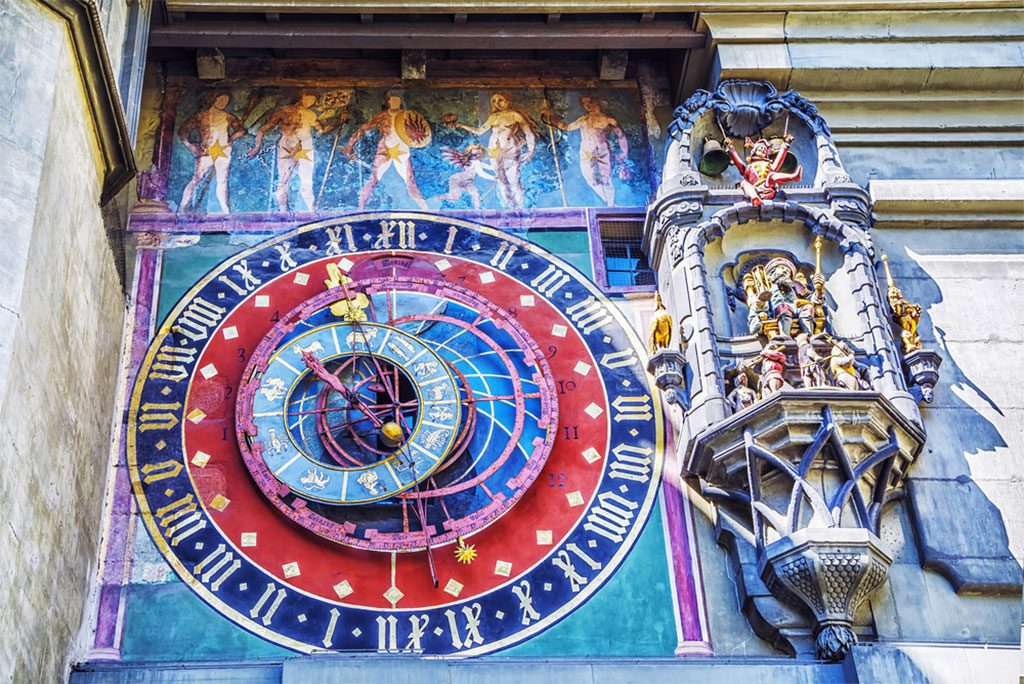
The medieval Zytglogge clock tower in Kramgasse street in the old city center of Bern, Switzerland. Image source: Marina Datsenko/Shutterstock.com
Bern’s oldest city gate, the clock tower gate, is also a fascinating historical landmark. The tower clock above the gate, which dates back to its construction in the 1100s, is one of the oldest and most impressive clocks in the world. This clock, which dates back to 1530, served as the city’s official timepiece for centuries. Photographers of all skill levels will appreciate the baroque style with its gilded embellishments. A single mechanism powers the tower’s astronomical clock, figurines, hour chimes, and two tower clocks. To a large extent due to this, Switzerland has been internationally recognized as a top area for clock production.
5. Bernina Express
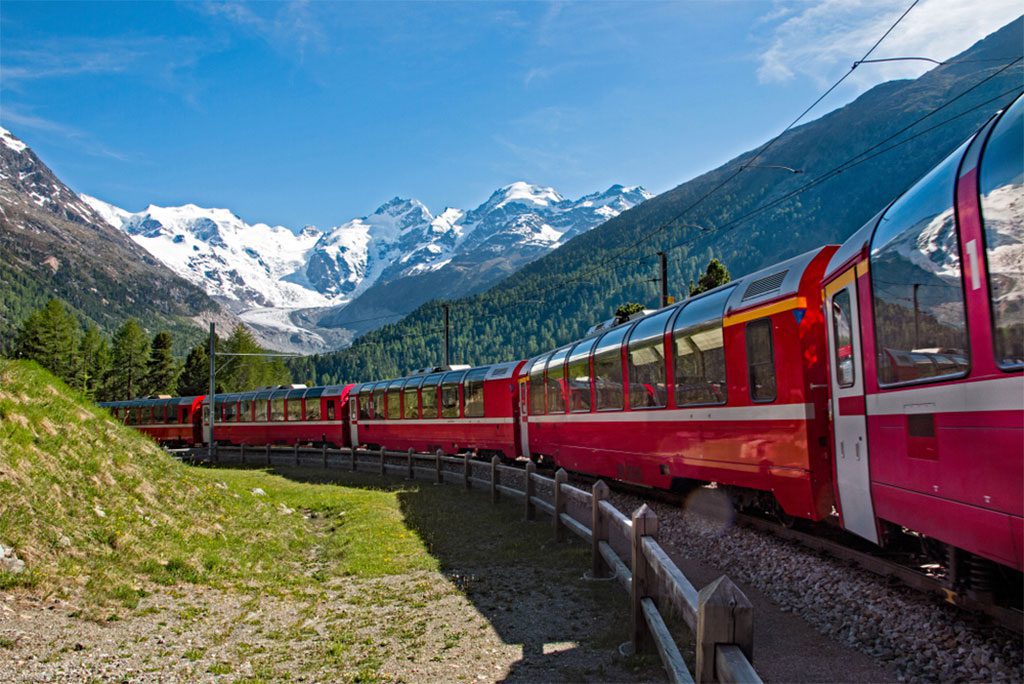
The famous Bernina Express train traveling through the Swiss Alps. Image source: Franco Bix/Shutterstock.com
The Bernina Express, a brightly colored scarlet train, travels from Chur, Switzerland, to Tirano, Italy, which is only over the border. The train ride takes around 4 hours, passes over 196 bridges, and travels through 55 tunnels, making it one of the most picturesque in all of Switzerland. While porters deliver snacks and beverages right to your seat, you can gaze out the window at the beautiful scenery as the train speeds by glaciers, mountain peaks, towns, bridges over 60-meter-high (200-foot) cliffs, and more. There’s no reason to skip this trip.
4. Chapel Bridge

A panoramic view of the historic city center of Lucerne, Switzerland. Image source: SCStock/Shutterstock.com
Located in Lucerne, Switzerland, the Chapel Bridge spans the Reuss River at a length of 204 meters, or about 670 feet. One of Switzerland’s most popular sights, it has the oldest wooden covered bridge in all of Europe. The covered bridge, built in 1333, was an important part of Lucerne’s defenses against invaders. A number of paintings from the 17th century portray historical events in Luzerne and can be seen within the bridge. The bulk of these paintings, along with most of the bridge itself, were lost in a fire in 1993; however, the structure was soon rebuilt.
3. Jungfraujoch
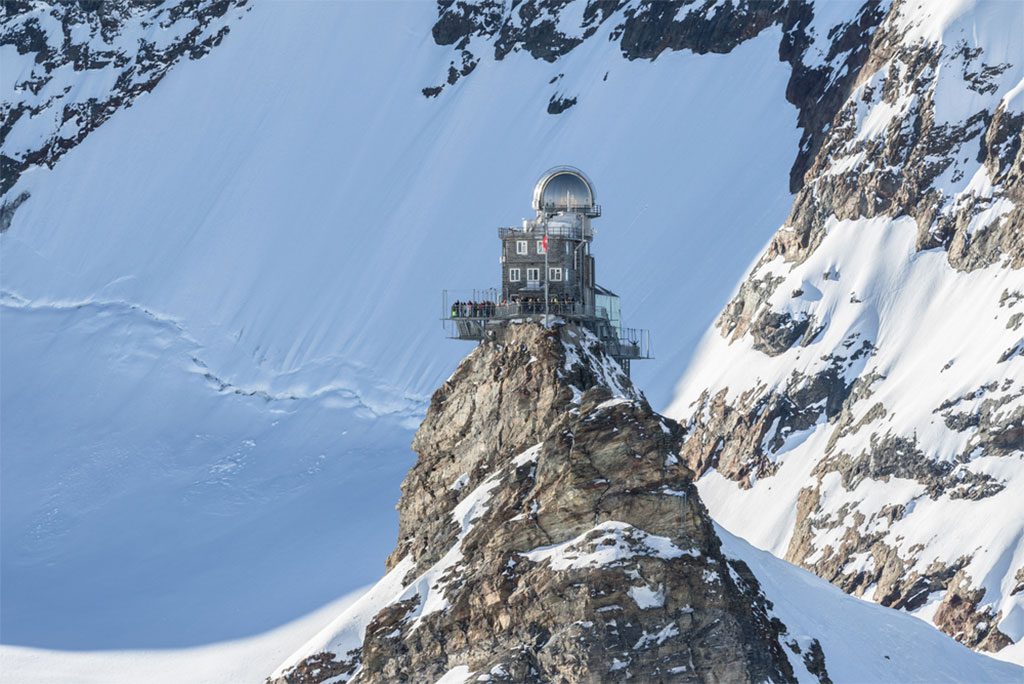
A stunning view of the Sphinx Observatory located on the Jungfraujoch mountain in the Bernese Oberland region of Switzerland. Image source: Peter Stein/Shutterstock.com
To reach Europe’s highest mountain station, take the train to the end of the Jungfraujoch, a col in the Bernese Alps. The enormous Eiger Glacier can be seen below the towering peaks of the Eiger, the Monch, and the Jungfrau, all of which are major tourist attractions. In addition, this area is home to the Sphinx observatory, one of the world’s premier astronomical observation posts. Extensive and unspoiled vistas can be found here; however, facilities are limited. No hotels or restaurants are available. However, the day trip on the train to see it and the experience will stay with you for the rest of your life.
2. Chateau de Chillon
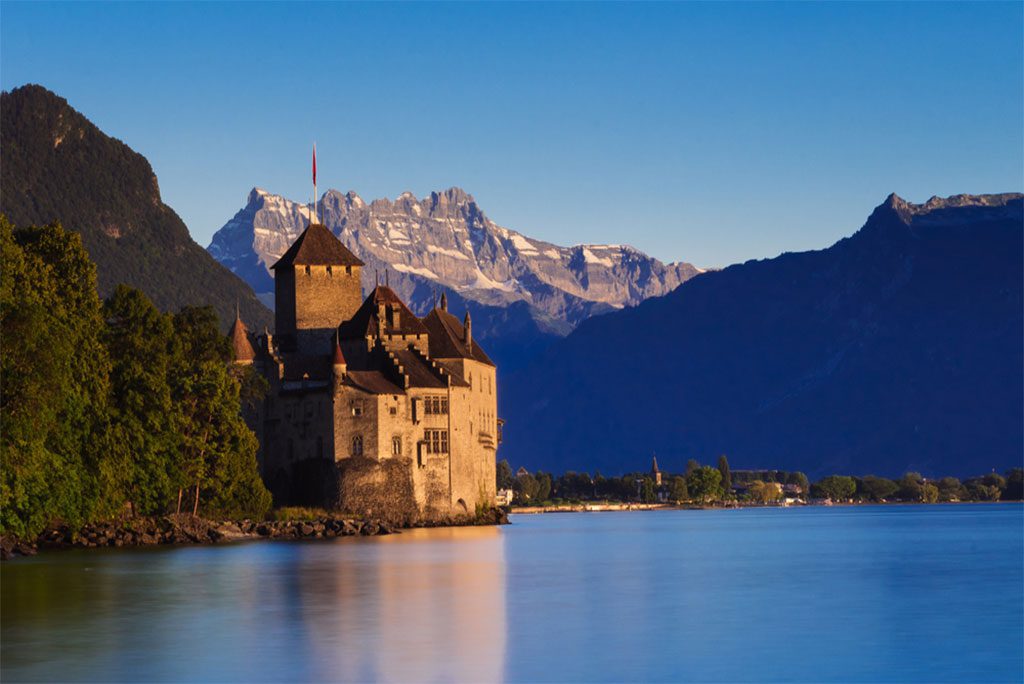
A stunning view of a beautiful chateau by a lake, with the Swiss Alps in the background. Image source: Ijby Berg/Shutterstock.com
On the banks of Lake Geneva stands Chillon Castle (Château de Chillon). For almost 400 years, the water castle served as the primary garrison, watching over lake traffic and protecting the land path leading to St. Bernhard Pass. The castle has underground vaults, 14th-century artwork, 25 individual structures, three courtyards, and two circular walls. Every year, the castle welcomes hundreds of thousands of visitors. The castle is available for private parties, perfect for those who want to host the wedding of a lifetime in the style of a classic fairy tale.
1. Matterhorn

A stunning view of the iconic Matterhorn Mountain in Switzerland. Image source: Jakl Lubos/Shutterstock.com
The Matterhorn stands as a symbol of the Swiss Alps and their famed mountain range. The German terms for “meadow” and “peak,” Matte and Horn, respectively, give the mountain its English name. It is one of the tallest mountains in the Alps, with a top that measures 4,478 meters (14,692 feet) and straddles the boundary between Switzerland and Italy. And it’s also one of the most dangerous Alps summits around. There have been 500 alpinist deaths on the mountain between its first ascent in 1865 and 1995. Since the Matterhorn’s faces are so steep, snow and ice can only cling to them in small, scattered patches, while the rest continually slides off and builds up on the glaciers below.


